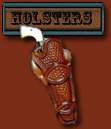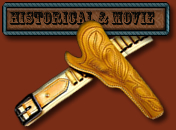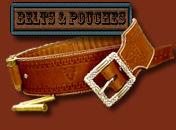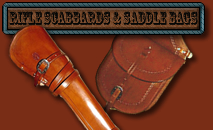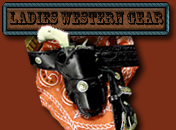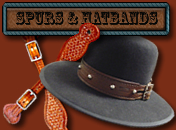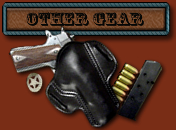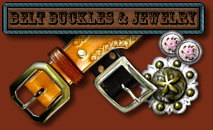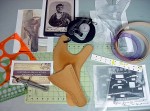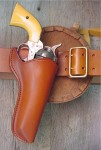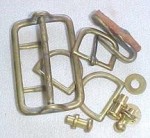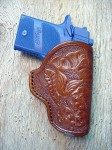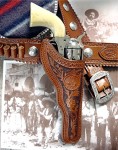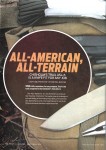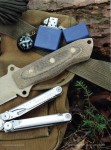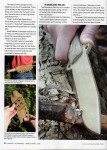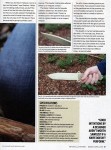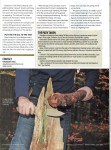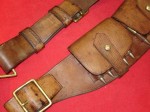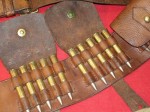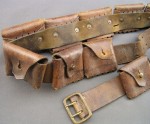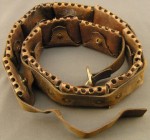Archive for the ‘Uncategorized’ Category
HISTORICAL GUN LEATHER ARCHAEOLOGY
Friday, June 5th, 2015We developed a Historical Gun Leather Archaeology analysis form that we use to record findings such as stitches per inch, width and thickness of the leather, markings including tooling, stamping, and maker’s names. The type of gun, barrel length and caliber are critical items that we record.
Original SAM BROWNE Buckle Sets & The Legend of the Lost
Thursday, June 4th, 2015LEGEND OF THE LOST ~
The prototype is finished, IN STOCK and ready to ship. Another pseudo western movie filmed in 1957 with some of the biggest stars of the era. The story line involves chasing after a long lost treasure in the Sahara desert. In this film, the Dukes rig consists of a period 2 1/4″ wide Sam Brown belt with a double tongue, solid brass, Sam Brown buckle. The belt has no bullet loops and the holster is reminiscent of his normal trademark leather except for the toe that is sewn closed. The gun is very unique in that it is a Swiss Model 1882 revolver in 7.5 MM caliber. Our set is made for a Colt SAA but we can adjust the pattern to fit an S&W or Colt double action. Belt, double tongue buckle, and holster set with normal Sam Brown buckle ~ $274.95 For a more authentic buckle, yours can be made with a genuine battle used, pre-WW1 Sam Brown buckle. Grab a piece of history for $24.95 more. Belt, double tongue buckle, and holster ~ $299.95
BJ- 78 SBH- SAM BROWNE DOUBLE TONGUE ORIGINAL BUCKLES SETS ~
We have been fortunate to obtain a “cashe” of pre and post WW ONE original Sam Browne complete buckle sets. The belts were in combat and were unusable so the brass parts have been carefully removed and preserved. They have not been buffed or cleaned up, but kept in their original state with patina. We have both the 2″ and the 2 1/4″ available as stock lasts. The enlisted men were issued a plain unlined belt with out lining or fancy stitching. The officers were required to obtain their own personal gear as long as the size and look fell into certain parameters. As a result the buckles varied greatly in their basic look as did the belts and the fancy stitching. Sold as sets only ~ $49.95
SIG SAUER P- 938
Friday, March 27th, 2015The new SIG SAUER P – 938 is probably the most dependable 9MM auto in the smallest size available today. Our International Agent holster provides a little FBI cant and the small auto is well seated and balanced in this holster in relation to the belt. We also give you enough room between the grip and the holster to get your hand around the gun to pull it out. With edge groove ~ $99.95. With one line of edge stamping ~ $119.95. With special “knurled” hand tooling ~ $124.95. With full coverage like basket weave or flowers & vines ~ $149.95. Single and double clip pouches available.
Click on photo for large view
NEW PANCHO VILLA HOLSTER, GUN BELT, AND BUCKLE
Friday, March 6th, 2015HH- PANCHO VILLA
This unique holster style is from the Mexican Revolution period. Notice the low cut front to allow for a faster draw. This pattern was traced from the original which had all the decoration shown actually hand sewn in a method called “Piteado,” which used the fibers from cactus as thread. Our version involves hand tooling and a pigskin lining. The back ground is hand darkened for contrast. Note the rampant Mexican eagle with a snake in its beak sitting on a cactus in the center. The belt has a scalloped lower edge and lazy S style tooling on the top and bottom. There are 5 domed conchos made from actual antique Mexican coins as well as a wide buckle adorned with flowers and vines. The color is saddle tan with a chocolate background. The rig, as shown, with one holster ~ $450.
FOR A LARGER VIEW CLICK ON PHOTO
CANADIAN SPECIAL FORCES EVALUATE CHISHOLM’S TRAIL ASL (Air, Sea, & Land) TACTICAL SURVIVAL KNIFE
Monday, March 2nd, 2015My first impression on removing the ASL-6 from its packaging was how solid it felt – a reassuring heft with clean, functional lines and a comfortable, hand-filling grip. The “taco” style kydex sheath and belt-clip are likewise simple in their execution, yet highly flexible (and ambidextrous) in deployment. My initial, positive impressions were all borne out (and then some) over the following days as I put the knife through a modest range of tasks. The ASL-6 is no lightweight, but it balances very nicely across the double guard with a slight handle heaviness that lends welcome agility to the blade. The 3/16” 1095 blade itself is extremely robust with a nicely executed convex grind and a sturdy drop-point thicker than most yet still capable of fine cutting tasks. This is a knife that epitomizes the “KISS” principle with features that allow it to perform well in a broad range of tactical and bushcraft roles from functional fighter to baton-friendly splitter of firewood. In short, the ASL-6 has everything you need, and nothing that you don’t. The Canvas Micarta grip scales feature comfortable palm-swells which afford a very positive grip whether wet or dry. In keeping with the knife’s multi-role nature, the beveled pommel is equally at home breaking glass or crushing skulls while the lanyard hole provides retention or a third point for lashing the blade to a pole (together with the holes in either side of the guard).
In its sheath the ASL-6 allows for comfortable belt-carry not possible with larger blades or inferior sheath designs. Alternatively, the sheath’s clip and lashing points provide for near-limitless modes of carry on all types of load-bearing equipment. This is a knife equally at home in the local bush or the Hinu Kush. Its near-perfect blend of simplicity and functionality make the ASL-6 a terrific all-around performer. It is a capable fighter when necessary and an excellent camp knife in near every regard. Equally at home chopping wood, cutting rope or skinning game – whatever your task the ASL-6 is ready.
Mark Campbell
Major (Retired)
Princess Patricia’s Canadian Light
27 years Mechanized and Airborne Light Infantry
ASL 6 COMBAT
KNIVES ILLUSTRATED DOES SIX PAGE ARTICLE ON THE ASL-6 TACTICAL KNIFE
Wednesday, February 11th, 2015We were very surprised and did not know this article was coming out on our new (Air, Sea, & Land) ASL -6 Tactical knife with the 6″ blade. This is the one knife you will ever need for survival, tactical, or bushcraft needs. This magazine is out now on the news stands as of February 2015. It is the MARCH-APRIL 2015. Volume 29. No.2 in case your bookstore is out of copies. You can order this issue or subscribe to KNIVES ILLUSTRATED by contacting them at this address:magazine-order.com
NEW ASL (AIR, SEA,& LAND) AD
Saturday, November 22nd, 2014This is the new ad that will be in the next issue of the “American Frontiersman.” There will also be a very nice article on our ASL knives in the same issue. This new magazine is worth getting a subscription to for the articles on survival and living on the frontier.
BANDOLIERS
Saturday, November 1st, 2014BANDOLIERS
Click on photos for a larger image
We have always been interested in the various ways military, law enforcement, and civilians carried their ammo back in “the day.” The encyclopedia says there are two spellings and both are right “ban·do·leer or ban·do·lier” and explains that it is a belt fitted with small pockets or loops for carrying cartridges and worn across the chest by soldiers. It was usually slung sash-style over the left shoulder because most people are right handed. This keeps the belt off of the right shoulder where the rifle stock is going to be when shooting. In addition, the bullet loops or pouches are then in good reach of your right hand to reload. A second belt with ammunition pockets was often photographed being across the midriff. At this point we would like to give a thank you to Grant of Medicine Hat, Alberta, Canada for his gracious input and consulting on our bandolier research. This post and article will continually change as new data and photos are found
If you ask just about anyone, the name “ Bandolier” immediately brings to mind an image of banditos along the border or gringos fighting for gold with Pancho Villa, galloping soldiers with criss crossed belts full of rifle and pistol bullets, or Mexican revolutionaries invading New Mexico. When you begin to study the research you will find that there were many variations of this belt at the turn of the century and they were more complex than just loops on a belt.
The Bandolier’s popularity got a huge booster shot in the arm after the 1969 western “The Wild Bunch,” by director/co-writer Sam Peckinpah. You can clearly see the Pattern 1882 flap bandolier, as well as the open loop style, being worn by Ben Johnson as a member of an aging outlaw band on the Texas-Mexico border struggling to exist as the changing world at the turn of the century threatens to engulf them. The Bandolier next was constantly visible in the “Star Wars” series of movies. Up until this point most bandoliers, even pre-1900 styles were plentiful and could be purchased for a very low price. Now, with so many folks collecting and re-enacting both of these movies, prices for good examples often go for over $200.00 if they can be found. One hundred year originals are often brittle or moldy and are not suitable for rough use. Therefore quality reproductions are actively sought after. At this time, with our research we can not find an American made flap bandolier of any style available. Chisholm’s Trail will now produce bandoliers with the best quality possible and made in the USA. Steer clear of foreign reproductions, they are very thin and have a terrible chemical smell which just can not be removed.
Three basic styles were prevalent: those with exposed bullets and loops, others with the loops and bullets covered with a flap, and finally actual pockets with flaps. The number of bullets and placement varied greatly as well as the makers. Homemade bandoliers usually were just loops sewn onto a belt and secured with a single or double tongue buckle. Colors ranged from natural through the shades of brown and black. As bullets changed, the folks that wore bandoliers found ways to tighten or open up the loops to fit the newer cartridge sizes. Many leather crafters copied bandoliers for their customers when military sources did not provide enough or other sizes were needed. In the US we refer to items as Model number or name. In Britain the items are called Pattern this or that.
The most common flap styles were variants of the British and other commonwealth nations. These saw use from the Turkish Ottoman Empire to the Mexican revolution and on to WW1 & WW2. The photo on the left shows the common straight belt with loops next to the curved 1882 bandolier belt.
1882 PATTERN- The earliest style often seen, after the looped style, was the British 1882 Pattern Cavalry bandolier. This was for the Martini-Henry Rifle. The bullet loops were originally .50 caliber, but later .303 was added. The large loops will also hold any .50 caliber round, 45.70, or .410 shot gun shells. Each ten bullet loop section had a flap that covered them securing with two Sam Brown Studs and straps. There were four large flaps and two smaller flaps with a fewer number of shells. (We will be offering this version and will be making a single pouch for pant belt use ) (Original in the Chisholm’s Trail cowboy leather collection)
1888 PATTERN- Next was the 303 LEE METFORD “88” Pattern which had five flaps attached to a belt. Under Each flap were five bullet loops. Each flap was oval and secured with a strap from the bottom attaching to a Sam Brown stud on the flap itself. The color was darker brown. (We will be offering this version and will be making a single pouch for pant belt use ) (Original in the Chisholm’s Trail cowboy leather collection)
1901 PATTERN- The “01” Pattern had 12 pouches and flaps and the bullet end protruded through holes in the bottom of each pouch. The brass buckle has two tongues. Notice the rivets holding the pouches to the belt. (We will be working on this version and will be making a single pouch for pant belt use)
We are looking for an original of this style. If you have one you would sell or let us borrow for a pattern, we would be grateful!

